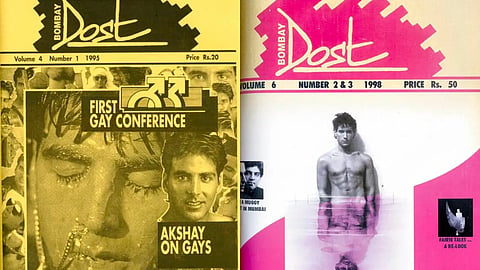
- HOMEGROWN WORLD
- #HGCREATORS
- #HGEXPLORE
- #HGVOICES
- #HGSHOP
- CAREERS
- ABOUT US
- CONTACT US

Bombay Dost magazines were discreetly wrapped in brown paper and distributed to small shops in India for the price of 15 rupees. They remained hidden in the back of these shops, never openly displayed, and were purchased in hushed tones and in a hurried manner, cautious as to not get caught.
In 1990, India's economy was yet to be liberalised, and the HIV crisis was peaking, leaving the gay movement fighting for its life. This is when, Bombay Dost, India's first LGBT magazine, decided to go into print.
Around this atmosphere, founder, Ashok Row Kavi felt the need to mobilise the gay community. This move was radical for its time because being gay in India was both legally punishable and socially unacceptable. Crucially, Bombay Dost recognised the need for a structured platform for the gay community.
The magazine's first issue, released in 1991, contained 16 pages and featured the groundbreaking article on Section 377 and its impact on HIV/AIDS outreach programs, authored by Mumbai's criminal lawyer, Shrikant Bhatt.
Thus, a movement started with the magazine's launch, which soon became an iconic symbol for the community. Bombay Dost fearlessly helped Indian gays understand their identity and connect with others like them.
The early days were fraught with challenges. With a careful lack of registration numbers and addresses, Bombay Dost distributed its initial 650 copies under the guise of 'people of alternative sexuality' and 'sexual minority'. It became more than just a printed publication; it served as an all-purpose platform, covering various subjects that mainstream media ignored. Copies were exchanged and passed through hundreds, striving to reach a wider LGBTQ audience.
The response was overwhelming, with the editors receiving up to 3,000 letters per week. The Khush Khat (Happy Letters) section, allowing readers to correspond and arrange meetings, was especially popular. It enabled gay Indians to connect discreetly, considering that coming out was still considered unthinkable for many at the time. The magazine also received letters from beyond Indian borders, including Tajikistan, Afghanistan, Dubai, and Iran, proving its impact reached far beyond national boundaries.
Aside from addressing health-related concerns, Bombay Dost also provided emotional and mental support for the community. The Papa Passion column functioned as an advice section, addressing questions ranging from sexual health to coming out to parents. The magazine also featured tear-me-out condom questionnaires and a gossip column titled Poison Pudi, which provided a glimpse into the city's gay scene.
All of this came to a sudden halt in 2002. The funds ran out. The magazine had to suspend publication due to financial constraints, lack of advertising opportunities, and time constraints for its volunteer staff. Nevertheless, the brand name was kept alive through a Yahoo!-hosted listserv and Sunday High events, providing hope for its return.
And return, it did. In April 2009, Bombay Dost made a comeback with its tagline 'bolder than ever'. The timing was opportune, coinciding with the Delhi High Court's landmark judgment, which decriminalised same-sex acts.
Today, The magazine expanded its coverage and audience, adopting a more mainstream and glossy appearance, featuring cover stories focused on films and celebrities. At its beginning, the magazine had a more radical and political approach. However, to battle against the plethora of online content in recent times, their cover stories have shifted towards a focus on films and celebrities. Notably, actors Imraan Khan, Kalki Koechlin and celebrity chef Vikas Khanna have been featured on the covers in the last few years.
From discreet brown envelopes to being boldly displayed in public, Bombay Dost succeeded in creating a landscape of queer South Asian-ness, reflecting their courage, resilience, and commitment to inclusivity and togetherness.
